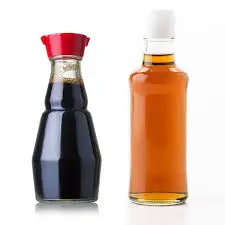Teriyaki Sauce vs. Soy Sauce: What’s the Difference?
Teriyaki Sauce vs. Soy Sauce: What’s the Difference?
Blog Article
When it comes to Asian cuisine, Teriyaki and soy sauces are two condiments that often take center stage. Both are savory, delicious, and staple ingredients in many dishes, yet they are far from interchangeable. Understanding their differences not only enhances your culinary skills but also ensures that you’re using the right sauce for the right dish. In this article, we’ll explore the key distinctions between Teriyaki sauce and soy sauce, their unique ingredients, usage, nutritional content, and much more.

What is Teriyaki Sauce?
Ingredients and Flavor Profile
Teriyaki sauce is a sweet and savory sauce typically made from soy sauce, mirin (a sweet rice wine), sake, and sugar. Some variations may include ginger, garlic, or honey for added flavor depth. This combination results in a thick, glossy sauce with a rich, umami taste that’s slightly sweet and tangy.
Usage in Cooking
Teriyaki sauce is commonly used as a marinade, glaze, or dipping sauce for meats, fish, and vegetables. It’s a staple in Japanese cuisine but has also found a home in various Western dishes. The sweetness of the sauce makes it ideal for grilling, broiling, and stir-frying, as it caramelizes beautifully when heated, adding a deliciously sticky coating to your dishes.
Nutritional Content
Teriyaki sauce tends to be higher in sugar and calories compared to soy sauce due to its sweeteners. It’s essential to use it in moderation, especially if you’re mindful of your sugar intake. However, it can be a source of some essential minerals like iron and calcium, depending on the ingredients used.
What is Soy Sauce?
Ingredients and Flavor Profile
Soy sauce is a fermented condiment made from soybeans, wheat, salt, and water. It has a salty, umami-rich flavor and is a cornerstone of many Asian cuisines. There are various types of soy sauces, such as light, dark, and tamari, each offering different levels of sweetness, saltiness, and viscosity.
Usage in Cooking
Soy sauce is incredibly versatile and can be used as a seasoning, marinade, or dipping sauce. It’s perfect for soups, stir-fries, dressings, and dipping sushi or dumplings. Its deep, salty flavor enhances a wide array of dishes without overpowering the other ingredients.
Nutritional Content
Soy sauce is generally lower in calories and sugar compared to Teriyaki sauce, but it is high in sodium. For those watching their salt intake, there are low-sodium options available that provide the same umami punch with less salt.
Key Differences Between Teriyaki Sauce and Soy Sauce
- Ingredients
- Teriyaki Sauce: Contains soy sauce, mirin, sugar, and sometimes additional flavorings like garlic and ginger.
- Soy Sauce: Made from fermented soybeans, wheat, salt, and water.
- Flavor Profile
- Teriyaki Sauce: Sweet, tangy, and savory with a thick consistency.
- Soy Sauce: Salty, umami, and thinner in consistency.
- Usage
- Teriyaki Sauce: Best used as a glaze, marinade, or sauce for grilling and stir-frying.
- Soy Sauce: Versatile seasoning for various dishes, including soups, marinades, and as a dipping sauce.
- Nutritional Content
- Teriyaki Sauce: Higher in sugar and calories.
- Soy Sauce: Lower in calories but high in sodium.
- Consistency and Appearance
- Teriyaki Sauce: Thick and glossy with a dark brown color.
- Soy Sauce: Thin, watery consistency, ranging from light brown to dark brown.
Can You Substitute Teriyaki Sauce for Soy Sauce?
While both sauces share a common ingredient—soy sauce—substituting one for the other can significantly alter the flavor of a dish. Using Teriyaki sauce in place of soy sauce will add sweetness, which may not be suitable for all food recipes. On the other hand, substituting soy sauce for Teriyaki will lack the sweetness and thickness, potentially leading to a less flavorful dish. For best results, use the sauce that complements the intended flavor profile of your recipe.
Choosing the Right Sauce for Your Dish
Selecting the right sauce depends largely on the dish you’re preparing. For a sweet, caramelized glaze on grilled chicken, Teriyaki sauce is your go-to. For enhancing the depth of flavor in a stir-fry or soup, soy sauce is the better choice. Both sauces have their place in the kitchen, and understanding their unique characteristics can elevate your cooking to new heights.
Conclusion
Teriyaki and soy sauces are integral to many dishes but serve distinct purposes in the kitchen. By knowing their differences in ingredients, flavor, and use, you can make informed choices to enhance your culinary creations. Whether you’re adding a sweet glaze or a salty punch, using the right sauce ensures your dishes are flavorful and true to their intended taste.
Report this page